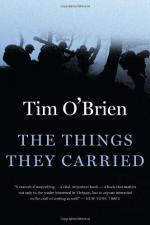|
|
The Things They Carried Topic Tracking: Truth
Chapter 2
Truth 1: In the second chapter Tim, the narrator, is introduced. Though the book is a work of fiction, Tim O'Brien the author and Tim O'Brien the narrator intermingle. The reader is not sure how much he or she knows about the story of Jimmy Cross: when Tim says he won't mention certain parts of it in his story, it's unclear whether he kept his promise or not. Did Jimmy want Tim to keep quiet, for example, about Ted Lavender's death? Or are there other secrets the reader is not told?
Chapter 3
Truth 2: Tim knows that certain stories, like the one about the soldier who goes AWOL, are true even if they are not factual. They are true because they feel true, and they convey something true about the situation they describe. Tim is a story-teller, and he wants to erase the difference between reality and story-truth.
Chapter 4
Truth 3: When Tim sees his past and future calling to him from the boat, the reader knows that this isn't exactly a true--or even realistic--story. Tim hears and sees people who the reader will meet later in the book. This gives the characters a sense of having always existed (they don't just appear and disappear as the storyteller needs them) but at the same time, this eternal quality makes them unreal.
Chapter 7
Truth 4: Tim says that a true war story cannot have any moral or meaning behind it. If it makes you feel good at the end, it isn't true. Only stories that reveal something obscene or evil about the people involved are true war stories, because there is no goodness in war.
Truth 5: Tim explains that what seems to be true is often the realest truth there is. Mitchell Sanders makes up details of his story to make Tim feel as if he were there: that is a kind of truth-telling. When Curt Lemon dies, Tim sees it all happen in a big confused jumble, and that is the truth of what happened. There are no details to sort through: it is the confusion that is true.
Chapter 9
Truth 6: Mitchell Sanders believes that a story has some kind of integrity--there's a right and a wrong way to tell it. Never add your own comments, he says. It ruins the flow of the story. But Rat Kiley wants the story to be believed, so he cannot just stick to the facts of what happened. In order to make the story believable, he has to add to it, either in imaginary details or in sideline commentary.
Chapter 16
Truth 7: Though the narrator of the story seems to be very clear-minded about the facts of Norman Bowker's story, the reader is never more confused about those facts than in this chapter. Who is the narrator? Is he the author, Tim O'Brien? He says he has been using Norman Bowker's real name, but is Norman Bowker a real person? The book is labeled a "work of fiction." How does one distinguish between truth and falsehood in made-up characters?
Chapter 17
Truth 8: Jimmy Cross at first believes with all his heart that Kiowa's death is his fault. Then he decides it was just an accident, and that is the absolute truth. He turns it over and over in his mind, but there seems to be no way to tell whether or not he should blame himself for not anticipating the flood.
Chapter 18
Truth 9: The narrator explains that what is made up is often truer than what actually happened, because it puts a face on faceless events and people. It gives specificity to general events. Tim saw many people die, though he was afraid to ever really look at any of them. Centering all his guilt and grief on one man, the dead Vietnamese man, allows Tim to explain his feelings in a way that would not be possible without these made up (though very true-to-life) details.
Chapter 22
Truth 10: In his stories, Tim plays with the truth. He has been doing this since he was a young boy, wishing his girlfriend back to life. He realizes that if you try hard enough and are creative enough, you can bring the dead back to life in stories. It doesn't matter whether the stories are exactly true--you can change the name, or location, or even parts of what happens--the feeling of truth will still be there. This is perhaps the essence of what Tim calls "story-truth"--not facts, but real feelings and impressions.




